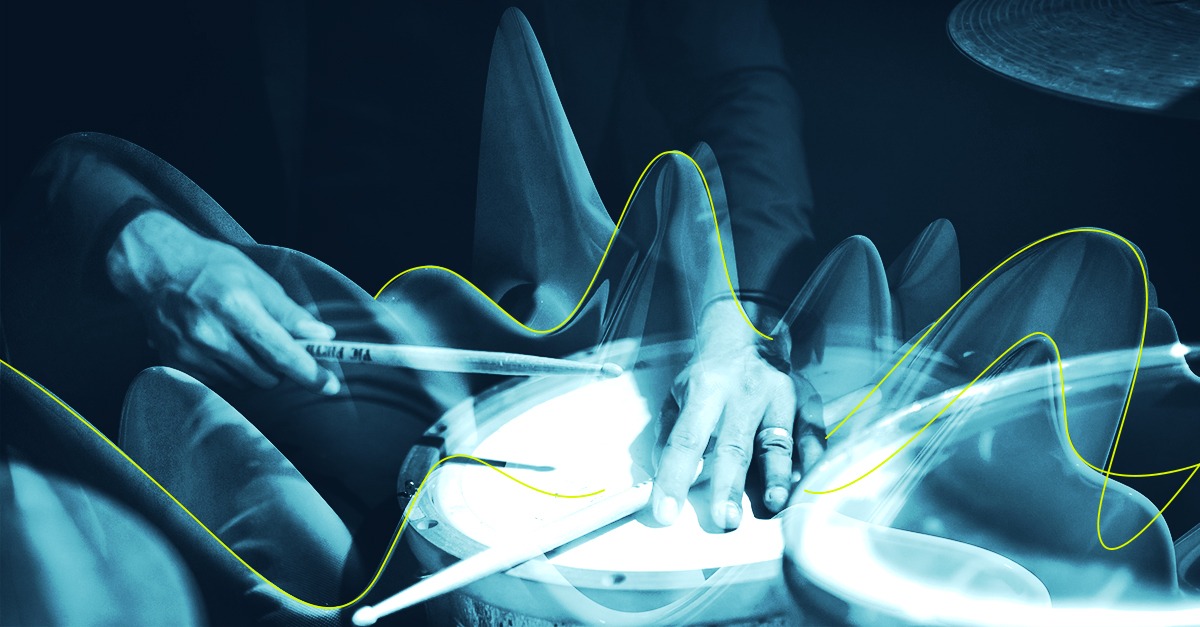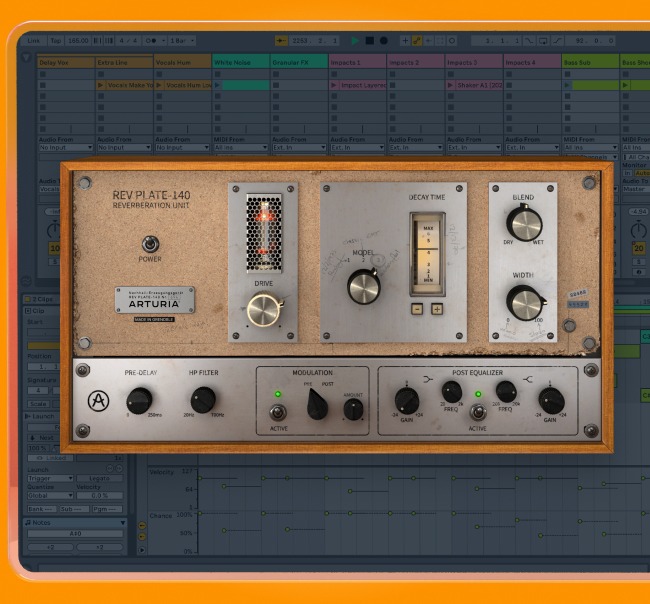
Gated Reverb: How to Create Unique Ambience Effects

Gated reverb might seem like a dated effect from a notoriously tacky era of music production.
But it’s a unique reverb type that’s much more versatile and effective than you might think.
If you’re looking for a less common form of ambience that can add punch, presence and space to your sound, gated reverb is worth a try.
But what is gated reverb? And how can you create it? What plugins do it best, and how do you set them up? Where do you even use gated reverb?
In this article I’ll explain everything you need to know.
Theory guides, production tips, new free plugins, gear guides and more—delivered weekly
Keep up with the LANDR Blog.
What is gated reverb?
Gated reverb is a form of artificial reverberation with a non-linear decay pattern.
Instead of gradually fading out like a traditional reverb sound, gated reverb cuts off abruptly at the end of its decay.
It’s called gated because the abrupt cutoff is similar to how a noise gate clamps down on a signal when it dips below the threshold.
In fact, inserting a gate plugin after a reverb is one way to create a gated reverb effect.
Other reverb plugins have dedicated non-linear modes to create unique reverb decay patterns, including gated reverb.
Instead of gradually fading out like a traditional reverb sound, gated reverb cuts off abruptly at the end of its decay.
Where to use gated reverb?
Gated reverb became popular in the 80s for its striking effect on drums.
The original gated reverb was created when engineer Hugh Padgham accidentally engaged the listenback mic while recording Phil Collins’ drums during sessions for this self-titled third album.
The console’s talkback system featured both a compressor and a gate to keep the levels in check while the function was active.
The compressor greatly exaggerated the room sound but the gate kicked in long before it could decay naturally.
The aggressive and powerful sound surprised everyone on the session and the effect became the centrepiece of Collins’ massive hit “In The Air Tonight”
Drums are still the most obvious place to use gated reverb. It adds the space and midrange push of regular reverb without the extended decay that can make it sound smeared and cloudy.
Gated reverb is often heard on snares and toms but can work on kick drums as well.
In addition to drums, gated reverb can be interesting on vocals as an engaging effect to give the vocal sound an unnatural texture.
In addition to drums, gated reverb can be interesting on vocals as an engaging effect to give the vocal sound an unnatural texture.
Experiment with gated reverb anywhere you need a stylish ambience effect to catch the listener’s attention.
How to get gated reverb
There are a few ways to get gated reverb depending on the style of effect you want and the specific sound you’re looking for.
Here are the two most common options:
Using a gate plugin after reverb
You can make your own gated reverb by using a reverb and gate plugin together.
When you create a reverb send using aux send and return channels, you set your reverb’s wet mix to 100%.
That way you can determine the blend of wet and dry signal by varying the level of the fader in your DAW’s mixer.
But if you insert a gate on the aux channel following the reverb, it’s action will only be applied to the wet signal.
That means when the level of the 100% wet reverb drops below the gates threshold it will cut off abruptly.
Experiment with the gate’s attack and release controls to sculpt the decay of the reverb and the intensity of the gated effect.
You can make your own gated reverb by using a reverb and gate plugin together.
Using a non-linear reverb mode
The gated reverb effects that became popular in the 1980s weren’t always done with a combination of traditional compressor and gate.
The earliest digital reverb processors offered producers new ambience textures that had never been heard before.
Several of the most popular units featured a non-linear mode meant to simulate the effect of a reverb tail in reverse.
The resulting sound gave an aggressive envelope to percussive material with a similar tone to the reverb and gate combination.
Different units had their own approach to non-linear reverb. There are a few notable types you’ll hear from popular hardware units with classic non-linear styles.
The Best Plugins for Gated Reverb
Goodhertz Megaverb
Goodhertz Megaverb is an advanced modern take on one of the most notorious digital reverbs of all time.
The innovative plugin builder doesn’t make it completely obvious, but the inspiration for Megaverb clearly comes from the humble Alesis Midiverb.
One of the first consumer digital reverb processors, the Midiverb had a distinctive sound not known for its subtlety or realism.
Even so, its nonlinear modes have a cult following for their weird and wonderful sound.
Megaverb goes far beyond the limits of the original hardware and can create exciting new reverb textures to use in your music.
Valhalla VintageVerb
ValhallaDSP is known for creating high quality reverb effects at super low prices.
VintageVerb is their take on a host of old-school reverb techniques from the early era of digital reverberation.
It includes an excellent non-linear mode that can give you all kinds of irregular envelopes including gated and reverse reverb.
UAD AMS RMX 16
The AMS RMX 16 digital reverb was one of the first widely available digital reverb devices. It changed what was possible for producers working with artificial ambience.
While digital reverb has come a long way since then, the old school sound of the RMX 16 is still sought after by producers—especially for gated reverb effects.
UAD’s plugin version of the AMS RMX 16 give you all the classic sounds the unit is known for, including its characteristic non-linear setting.
Your reverb plugin of choice
As I mentioned above all you really need for gated reverb is a reverb plugin and a gate plugin.
That means you’re free to use whichever reverb plugin you prefer to create the basic effect.
Try experimenting with different reverb and gate plugins to find the best combination for your mix.
Try experimenting with different reverb and gate plugins to find the best combination for your mix.
Inspiring reverb sounds
Gated reverb is a classic production trick you should have in your toolbox.
Even if gated reverb dates from a specific era of production it still has plenty of uses in modern mixes.
Luckily it’s not a difficult effect to achieve with the right plugins.
If you’ve made it through this article you’ll have a great start for working with gated reverb in your music.
Gear guides, tips, tutorials, inspiration and more—delivered weekly.
Keep up with the LANDR Blog.




